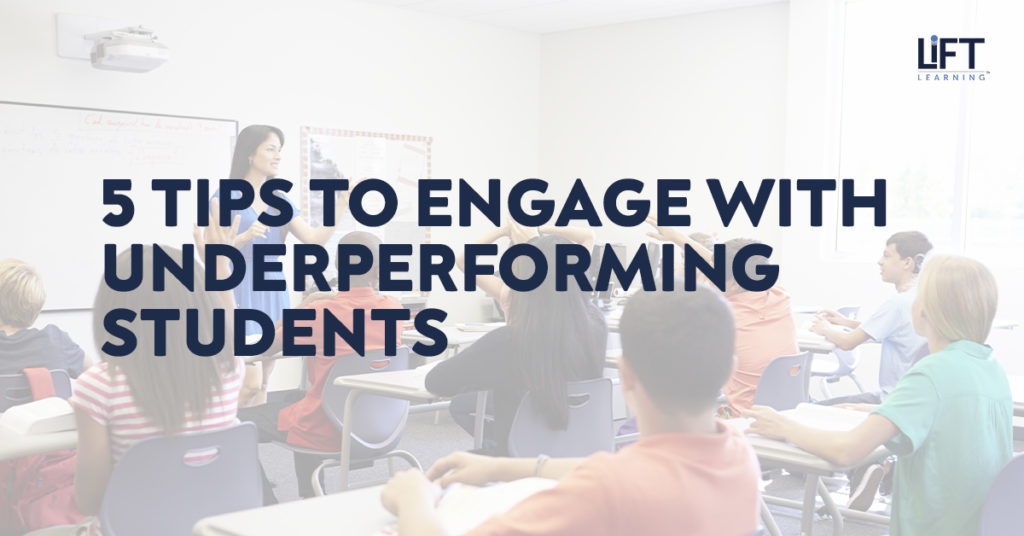5 Tips to Engage with Underperforming Students

Increasing student achievement in traditional academic outcomes such as literacy, numeracy, and content knowledge is vital for post-secondary success. In recent decades, the definition of achievement has expanded to include essential skills like the 4C’s, Career Readiness, Wayfinding, and Social-Emotional Learning.
This expanded definition of student success has been necessitated and accelerated by many factors, including advances in learning science, technological disruption and innovation, the burgeoning gig economy, increasing automation in the workplace, and increasing rates of anxiety and depression in teens.
Educators must now focus on helping youth develop content knowledge and these transferable skills, so they will be able to adapt to changing conditions.

When students struggle to find success in any learning area – academic, social, emotional, or otherwise – increasing engagement is vital.
Many educators have little training in engagement strategies for underperforming, disengaged, or reluctant learners. Some of the traditional engagement strategies, such as enforcing more study time, warning them about negative consequences, offering rewards for ‘doing better,’ and even bringing in a specialist can sometimes even backfire.

Here are five tips to re-engage learners who are struggling to find success:
1. Release Pressure to Reduce Stress.
Having high expectations doesn’t mean a relentless pressure campaign. We all learn best without stress. If stress, frustration, and a sense of failure have crept in, it is worth taking a step back and reminding the student that these things take time and there is no failure in school, only progress.
Share a smile, take a break, and let them know there is more to them than this one frustrating challenge.
2. Find a Personal Connection to the Content.
We’re good at what we like, and we like what we’re good at, so connecting content to what is personally important and meaningful is essential. Not only does this give a boost to motivation and effort, but it also builds a stronger trust relationship between students and teachers.
Dig a bit to find a personal connection between a student’s interests and the subject, no matter how small.
3. Demonstrate Empathy with a Story.
Share a story about something you struggled to learn personally or about a former student who also had a hard time.
Did you just ‘muscle through it’ and move on to other things? Did you discover something about yourself you wouldn’t have known otherwise? Did you end up liking the subject after all?
As social learners, we all struggle to learn complex subjects, so demonstrating empathy with a personal story is a powerful tip to increase student engagement in the classroom. Elevate Academy wrote a great article on ways to celebrate cognitive conflict.
4. Borrow from their Past Success.
Ask them to describe a time where they successfully overcame a similar challenge. Then, explore what worked before and apply those strategies to the current challenge.
Did the student make a study schedule? Find a different environment to complete their work? Did they break things down into tiny tasks? Did they work with a tutor?
You may have to interview your students to find out what worked, but tapping into past success and generalizing it to meet the current challenge is incredibly empowering.
5. Look at the Bigger Picture.
When we’re overwhelmed with life, we’re less available for learning. Check whether the achievement challenge is localized or may be part of a more significant pattern of struggle.
Family dynamics, social pressures, physical and mental health challenges, and unrecognized learning differences may contribute to the students’ ability to engage in the classroom.
Respectfully check in with your student with colleagues and make appropriate referrals.
Remember: Engaging with Underperforming Students Gets Easier.
You don’t have to wait for disengaged students to struggle – you can begin applying these tips in the classroom today. They’ll help build a foundation of trust that will make it much easier to navigate future challenges. Taking the time to proactively apply these five tips for re-engaging students is a great way to keep the entire classroom motivated, connected, and excited to learn.
See How LiFT Learning Empowers Teachers to Empower Learners: Watch Our PBL Platform Demo Video

